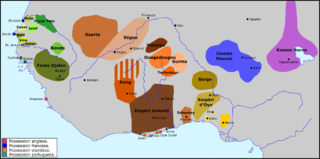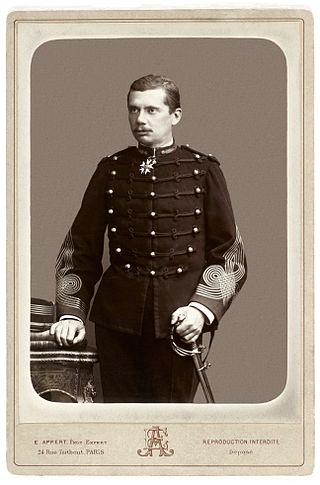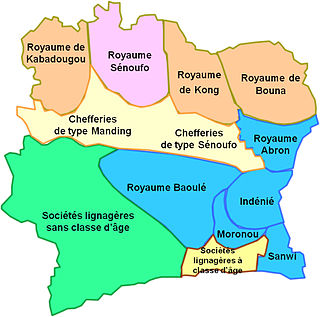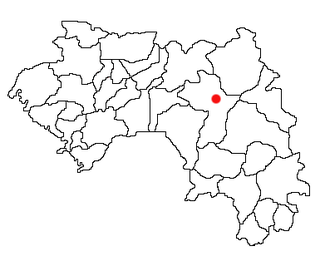
Bamako is the capital and largest city of Mali, with a 2022 population of 4,227,569. It is located on the Niger River, near the rapids that divide the upper and middle Niger valleys in the southwestern part of the country.
The Dyula are a Mande ethnic group inhabiting several West African countries, including Mali, Cote d'Ivoire, Ghana, and Burkina Faso.

Samory Toure, also known as Samori Toure, Samory Touré, or Almamy Samore Lafiya Toure, was a Mandinka Muslim cleric, military strategist, and founder of the Wassoulou Empire, an Islamic empire that was stretched across present-day north and eastern Guinea, north-eastern Sierra Leone, southern Mali, northern Côte d'Ivoire and part of southern Burkina Faso. A deeply religious Muslim of the Maliki school of religious jurisprudence of Sunni Islam, he organized his empire and justified its expansion with Islamic principles.

Kankan is the largest city in Guinea in land area, and the third largest in population, with a population of 198,013 people as of 2020. The city is located in eastern Guinea about 555 kilometres east of the national capital Conakry.

Wassoulou is a cultural area and historical region in the Wassoulou River Valley of West Africa. It is home to about 160,000 people, and is also the native land of the Wassoulou genre of music.

Tieba Traoré was the fourth king of the Kénédougou Empire, reigning from 1877 until his death in 1893.

The Wassoulou empire, sometimes referred to as the Mandinka Empire, was a short-lived West African state that existed from roughly 1878 until 1898, although dates vary from source to source. It spanned from what is now southwestern Mali and upper Guinea, with its capital in Bissandugu; it expanded further south and east into northern Ghana and Ivory Coast before its downfall.

The Kénédougou Kingdom,, was a pre-colonial West African state established in the southeastern portion of present-day Mali, as well as parts of northern Cote d'Ivoire and western Burkina Faso.

Bissandugu is a city in southwestern Guinea on national road nb 1. In the nineteenth century, it was the base for Samori Ture, a Dyula warlord who named the city in 1878 as the capital of his Wassoulou Empire (1861-1890). Ture was known for his resistance to French colonial forces and prevailed against them and smaller African states for years.
Manga Sewa was a Yalunka King of the Solimana who blew up a magazine and much of Falaba, the capital of Solimana, killing himself, his family and other leaders, rather than let it fall to Samori Toure's army.

Kouroussa or Kurussa is a town located in northeastern Guinea, and is the capital of Kouroussa Prefecture. As of 2014 it had a population of 39,611 people. A trade center and river port from at least the time of the Mali Empire, Kouroussa has long relied upon its position near the upstream limit of navigation of the Niger River to make it an important crossroads for people and goods moving between the Guinea coast and the states of the western Soudan and Niger River valley. The town and surrounding area is a center of Malinke culture, and is known for its Djembe drumming tradition.
Touré is the French transcription of a West African surname. The name is probably derived from tùùré, the word for 'elephant' in Soninké, the language of the Ghana Empire. The clan existed as kings of Zaghari on the middle Niger before the Moroccan invasion of Ghana. A theory of their origin holds that the Touré are descended from the "Roum," pre-Arab North African soldiers, and local women.

The Kong Empire (1710–1898), also known as the Wattara Empire or Ouattara Empire for its founder, was a pre-colonial African Muslim state centered in northeastern Ivory Coast that also encompassed much of present-day Burkina Faso. It was founded by Dyula immigrants from the declining Mali Empire. It established a largely decentralized commercial empire based upon linkages by merchant houses protecting trade routes throughout the region. Kong rose to prominence in the 1800s as a key commercial center and center of Islamic studies. In 1898, Samori Ture attacked the city and burnt it down. Although the city was rebuilt, the Kong empire had dissipated and the French took control over the area.
Sofa is a Mandinka term for slave soldiers who served in the army of the Mali Empire. Sofas would also fight, in varying capacities, in the armies of later Mandé states such as the Bamana and Wassoulou empires.

Gustave Borgnis-Desbordes was a French general. He was a major figure in the French Imperial conquest of the French Sudan, modern Mali. He was Commandant-Superior of the French Military Territory of Haut-Sénégal, attached to the colonial government of Senegal, 1880 to 1883.
Kiniéran is a town and sub-prefecture in the Mandiana Prefecture in the Kankan Region of eastern Guinea. As of 2014 it had a population of 37,944 people.

The Kabadougou Kingdom was a Malinké warrior kingdom situated in north-west Côte d'Ivoire centered on the town of Odienné and bordered the Kingdom of Worodougou. It was ruled by the Touré dynasty, whose founder centered the society around slavery. The dynasty in an alliance with Samori Ture fought French colonization until 1898.
The Batè Empire was a pre-colonial state centred on Kankan in what is today Guinea. Founded by Mandinka and Soninke people as an Islamic merchant state in the 16th century, it survived until the late 19th century when it was conquered first by Samori Ture and then incorporated into French Guinea.

Kouroukoro is a town located in northwestern Guinea, and the capital is Kouroussa. It has an estimated population of a few thousands. The town and surrounding area is a center of Malinke culture. Kouroukoro was a district in upper Guinea, Republic of Guinea, West Africa. From early 2021 Kouroukoro was upgraded by the government to the rank of Sub-Prefecture i.e. it now has other districts that are under it politically. They are Districts of Niemen, Saramadia, Kankaya and of course Kouroukoro. It is part of the Prefecture of Kouroussa Kouroukoro lies about 500 km from the capital Conakry, about 50 km from the prefecture of Dabola and about 95 km from the prefecture of Kouroussa
The Battles of Woyowoyanko are two military engagements that were fought near the Woyowoyanko river in April 1883, during the wars between France and the Wassulu Empire of Samori Ture in West Africa.












